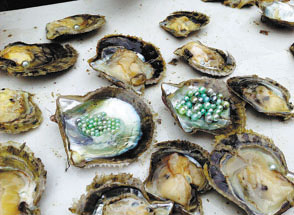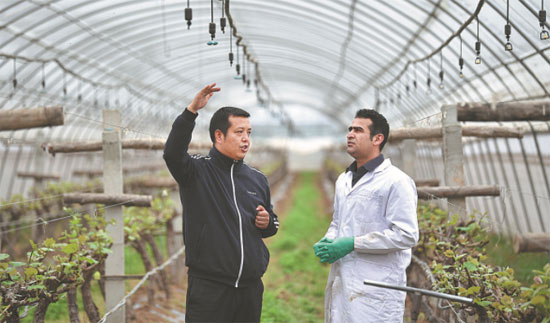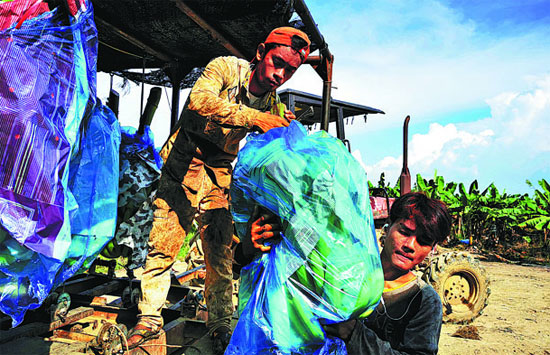Editor's Note: People-to-people exchanges are deepening the connections between countries participating in the Belt and Road Initiative. This column celebrates the efforts of those working toward a shared future.
They're quite small and irregular in shape, but that's not the first thing you notice about the seawater pearls nestling in Shi Chengkai's hand. It's the striking colors. The typical pearls sold in the market-large and round-come only in white or black.


Dazzling colored pearls from Beihai. [Photo provided to China Daily]
"These colors - green, pink, and purple-are all natural and formed with the growth of pearls, and will not fade away no matter how you clean them," says Shi, who began studying and cultivating colored pearls in the 1990s in the city of Beihai, in the Guangxi Zhuang autonomous region.
Unlike some dyeing methods used in the past, Shi uses a special biotechnology known as the directed breeding technique to change the color of the nucleus and cell sheet that are inserted into the Hepu pearl oyster. The very different colors will then be naturally formed during the oyster's secretion of proteins.
The Hepu pearl, widely known as the Southern pearl, is considered the best pearl in China with a history of cultivation going back more than 2,000 years. It is named after its place of cultivation, Hepu county in Beihai, an important stop along China's ancient maritime Silk Road.
This technology has been identified by the region's Department of Science and Technology as a world first, and won the first prize in the Guangxi Science and Technology Progress Award in 2006.
Since 2013, Shi, president of Beihai Yuanlong Pearl, has been busy taking his pearl cultivation technology abroad, and the Belt and Road Initiative has fired up his ambitions along with making available the support he needs.
Agricultural exchanges and trade were vital elements of the ancient Silk Road, and they remain the economic foundation of the countries involved in the Belt and Road Initiative. This enduring legacy makes agriculture an essential element for cooperation among the participating countries.
In May 2017, an action plan for the joint promotion of agricultural cooperation under the initiative was launched by four Chinese ministries and departments: the Ministry of Agriculture, the National Development and Reform Commission, the Ministry of Commerce, and the Ministry of Foreign Affairs.
The plan was conceived to contribute China's wisdom to the global governance on food and agriculture, enabling the nation to share its experiences with BRI countries so as to contribute more to the world's agricultural and economic growth.
Also in 2017, Beihai Yuanlong and the University of Malaysia Sabah reached an agreement for the establishment of a shellfish laboratory drawing on expertise from China and Malaysia. The project aims to establish two experimental sites, at the university and in Beihai. Malaysia is one of the 10 members of the Association of Southeast Asian Nations and an important participant in the BRI.
Through the laboratory, Chinese and Malaysians have begun carrying out scientific research on the breeding, selection and reproduction of pearl oysters, as well as on the protection of shellfish species in addition to genetic engineering technology relating to the creatures.
The lab passed the regulatory clearances in early May this year and was officially unveiled. On the Malaysian side of the operation, five scholars contributing their know-how, and dozens of local workers shoulder the work of oyster seeding and maintenance tasks at the site.

A Pakistani student gets pointers on March 17 about irrigation systems at a cooperative established in an agricultural technology demonstration center in Shaanxi province. [ZHANG BOWEN/XINHUA]
Collaboration model
Shi says that this cooperation model-integrating research from industry and academia-not only guarantees a pipeline of professional talent but also ensures that the scientific research results can promote the upgrading of the industry.
In October 2018, the company signed a strategic agreement with the fisheries authorities in Sabah state on the promotion and development of pearl cultivation technology and the industry in Malaysia to further benefit people from both countries.
Under the agreement, the two sides set up pearl cultivation sites in the Malaysian coastal communities of Kudat, Bangi and Semporna. The operation covers 2,000 hectares.
More than 300 Malaysians have been trained up in the technical skills required, greatly advancing the development of Malaysia's pearl industry, Shi says.
The spirit of cooperation has extended to the Philippines. In April 2019, the Institute of Oceanology at the Chinese Academy of Sciences and the Iloilo Campus of the University of the Philippines signed a memorandum of cooperation.
Under the arrangement, the two sides will cooperate in the fields of aquaculture, marine biology, biotechnology, marine ecology as well as on research and development related to seaweed cultivation. They also reached a consensus on academic exchanges and training.

Workers carry bunches of freshly picked bananas at the Cambodia-China Tropical Eco-Agriculture Cooperative Demonstration Zone in Kratie Province in July last year. [MAO PENGFEI/XINHUA]
Huge potential
Long Wen, president of the China-ASEAN Chamber of Agricultural Commerce, says there is huge potential for even greater agricultural cooperation between the two sides.
China has advanced agricultural production technology, high-quality products, and an abundant supply of agricultural materials, he says. Within the ASEAN countries, Long says, there is great potential demand for what China produces, and their agricultural products also enjoy strong market demand in China.
Reflecting this demand, Guangxi in 2020 selected 30 crop varieties in an agricultural and fishery cooperation demonstration zone in Malaysia.
Guangxi has also pursued the implementation of 22 projects relating to agricultural opening-up and cooperation pilot zones, exporting more than 750 new varieties of vegetables and rice to ASEAN countries such as Vietnam, Laos and Brunei.
So far, Guangxi has established 12 agricultural science and technology parks with ASEAN countries, including the China-Vietnam Border Agricultural Science and Technology Corridor, the China-Laos Cooperative Agricultural Science and Technology Demonstration Base, and the China (Guangxi)-Cambodia (Siem Reap) Agricultural Science and Technology Demonstration Park.
As for the pearl sector, efforts by the likes of Shi Chengkai to expand production and research links with peers abroad are helping to save the industry itself.
China established its first pearl cultivation operation in 1961, in the Beibu Gulf, in the northwestern reaches of the South China Sea. It was set up to boost pearl production in China.
But, in the wake of reclamation works beginning in 2004 for port construction, the sea became polluted. The fortunes of the seawater pearl sector there have since waned.
Meanwhile, the excessive expansion of breeding areas placed too much strain on the environment, causing the deterioration of the aquaculture area. Super-density farming has also led to a sustained decline in the quality of pearl oysters.
After rounds of investigations, a team of governors, experts and local pearl farmers decided to adopt a series of comprehensive strategies to address the issue-to find a better environment for pearl cultivation.
Shi says that Semporna, on the east coast of Sabah, has clear seawater, rich marine biodiversity, and a suitable coral ecology, and that mix makes it "an excellent place for pearl oyster to grow".
He says the cooperation efforts could lead to the separation of breeding and processing, promoting the internationalization of the Southern pearl. In doing so, a sustainable development path will open up for the revitalization of enterprises built around the Southern pearl.
"We must protect our natural resources and ecology so that our future generations can have sustainable and better development," says Shi, who is the second generation in his family to engage in pearl cultivation technology.
Vincent Martin, former representative of the United Nations' Food and Agriculture Organization in China and the Democratic People's Republic of Korea, says the China-proposed BRI has provided immense opportunities for countries and regions to achieve sustainable agricultural development.
"China also changed its agriculture pattern toward more sustainable practices through a series of measures from policy reform, implementation of new technologies, and researches in agriculture, which is important not only for China but for the rest of the world," he says.
Martin and Shi are reading from the same page. Shi hopes the cooperation project in which he is involved will transform the local labor force, as it draws on the resources of the Malaysian university to nurture more professional and technical talent.
In this way, he says, it can accelerate the internationalization of pearl cultivation standards, including for colored pearls.
"I also hope to establish a China-Malaysia industrial park, where some of the technological transformation achievements can be introduced," he says.